Namesakes.
Peaceful and forgotten, three men named Stephen W. (for Whitaker) Fullerton lie at rest in Middletown’s history-rich Hillside Cemetery. Their connection to Newburgh is hidden in plain sight – on the street signs of Fullerton Avenue, where generations of young people have passed through the front doorway of Newburgh Free Academy.
Looking back opens a 19th-century window to when Newburgh was closely connected with the rest of Orange County, and both City and County were far busier and more thriving places than today. Sorting out their personal stories also uncovers unfortunate mistakes and gaps in existing records.
The mini-saga begins with the family patriarch, Stephen W. Fullerton, Sr. (1792-1855), a dairy farmer in tiny Slate Hill. Stephen, Sr. and his tough-minded wife Esther (1792-1877) raised 12 children on the farm and achieved some local stature. The dairy farmer became a Justice of the Peace and was sometimes referred to as Judge Fullerton. His matriarch wife was a local fixture who dispensed advice about home remedies and retold ancestral stories about the hardships of pioneer life.
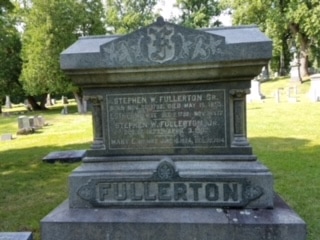
Three of the boys became lawyers – which is where the Newburgh connection really begins. A 1906 essay about the Fullertons by Walter C. Anthony, President of the Newburgh Historical Society, described what must have been the farm boys’ earliest contact with the growing port town on the Hudson:
Orange County…in those days…was somewhat like a frontier country…Newburgh was the market town for the people of all that section of Orange County. Their trip to this city involved a drive of 25 to 30 miles each way and such a drive was itself a stern test of endurance and strength.
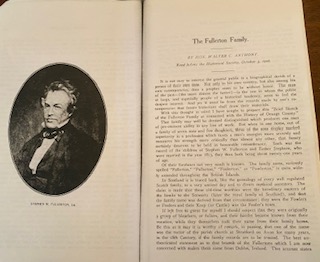
Clearly, the three young men – Daniel, William, and Stephen, Jr., — found better opportunities in contentious mid-19th-century courthouses than in the physical rigors of farming. Orange County’s economy and population were expanding rapidly, and so was its litigation.
At the time, there were no specific educational requirements for admission to the bar – an aspiring attorney would prepare for the exam while serving as an apprentice to a practitioner. But there was a lively rivalry between the lawyers of Goshen and Newburgh. Each village had its own stately courthouse designed by Newburgh’s Thornton Niven. In an era when there was little in the way of public entertainment, an exciting court case would draw a huge crowd.
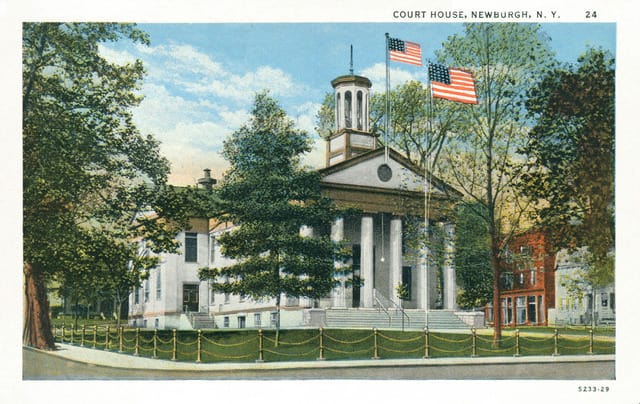
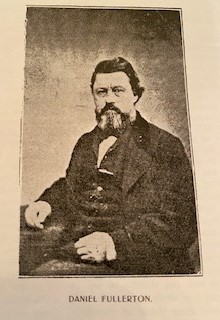
More broadly, with the growth of the newspaper industry over the course of the century, great trial lawyers would become celebrities, as well-known to the public as boxers and racehorses.
Daniel Fullerton (1814-1865) x was the oldest of three attorney brothers. He was described by a respected peer as “the lion of the tribe of Fullerton,” and was a force in local politics. But for reasons not entirely clear, his practice was limited to minor courts around Goshen and he never achieved the prominence of his younger siblings.
The two younger brothers were drawn to Newburgh. And eventually, Daniel’s own son, the future Civil War Captain and the third member of the family to carry the name Stephen W. Fullerton followed in his uncles’ footsteps and began his law career in Newburgh.
The Famous Judge Fullerton.

Judge Fullerton Cabinet Card
William S. (for Stephen) Fullerton (1817-1900) practiced in Newburgh for roughly 10 years, during which time he was known as the “Orange County cyclone”. In 1852, there was a major career break when he was invited to join Charles O’Conor as a partner in his Manhattan law practice. In his day, O’Conor was a legendary trial lawyer. Work-obsessed, O’Conor was a notoriously solitary and difficult personality, with next-to-no personal life.
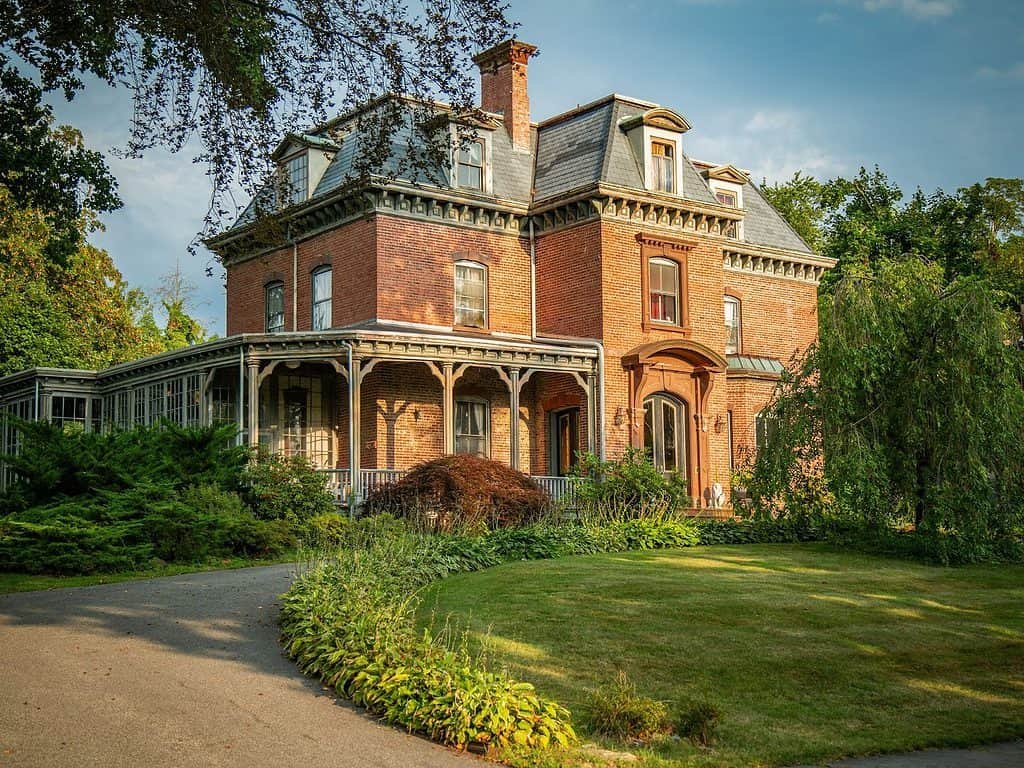
William accepted the offer and moved his professional life to New York City, while his own family remained in Newburgh. The gracious 1868 family home at 297 Grand Street, is still known as the Fullerton Mansion.
The family’s only son, future composer William Fullerton, Jr., was born in 1854, two years after his father had relocated his professional life.

By 1860, Fullerton had created his own law firm and in 1867, he had received a short-term appointment to fill a vacant position (due to a judge’s death) on the New York Supreme Court. Over the years, his skill at cross-examining hostile witnesses and flair for courtroom drama made him a favorite of the press and public. His performance in a famous 1875 adultery case, Tilton v. Beecher, made “Judge Fullerton” a household name.
A Less Famous Judge Fullerton.
The youngest of the three lawyer-brothers, Stephen W. Fullerton, Jr. (1823-1902) also migrated to Newburgh, where he practiced law for more than 20 years, until finally joining his brother’s busy Manhattan firm in 1872. Stephen, Jr., served a one-year term as an elected County Judge; so he too was sometimes called Judge Fullerton. But everyone called him Whitaker, or “Whit.”. This may have been a play on words – referring to his middle name Whitaker and also his quick wits in the courtroom and penchant for practical jokes. 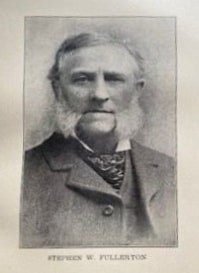
According to Russel Headley’s 1909 History of Orange County, the top lawyers in Goshen considered Whit their chief rival in Newburgh. One of his local law partners was a younger friend – Walter C. Anthony – which helps explain Anthony’s later interest in Fullerton family history.
In addition to the 1906 Historical Society essay mentioned earlier, Anthony published a 1916 history of the Orange County Bar, filled with biographical sketches, personal anecdotes, and memories of fraternity-like bantering in open court. “Whit” comes across as a widely admired and beloved figure, who took cases regardless of ability to pay and gave away large sums to help others in need.
He was also known for speculative investments – mostly unsuccessful. But for some reason, the local Orange County histories do not mention the racehorse.
The Most Famous Judge Fullerton of All.
Sports historians have described harness racing as America’s first professional, spectator sport. And the rolling hills of Orange County were an excellent place to raise trotters. During the 1870s, one of the best-known, and most profitable, was named Judge Fullerton.
A front-page 1877 article in the popular maga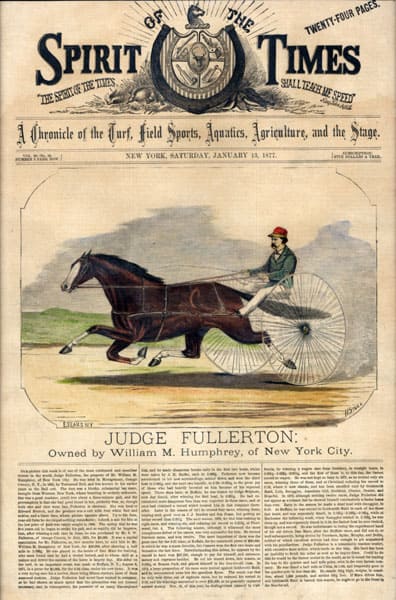 zine “Spirit of the Times” explained that in July 1870, S.W. Fullerton of Orange County had purchased a horse named Bull’s Colt, from a farm in Montgomery, for $ 3,000. Two months later he sold it for $ 20,000. The new owner changed the horse’s name to Judge Fullerton and placed it in the hands of legendary harness race driver Dan Mace. Judge Fullerton was soon setting course records, and earning enormous sums of money, although often finishing second or third, due to being pitted against the speediest trotters of the period. Surviving first-hand accounts, as well as Currier and Ives prints, capture the sense of breathless crowds filling the stands to watch epic contests between Judge Fullerton and great competitors like Goldsmith Maid.
zine “Spirit of the Times” explained that in July 1870, S.W. Fullerton of Orange County had purchased a horse named Bull’s Colt, from a farm in Montgomery, for $ 3,000. Two months later he sold it for $ 20,000. The new owner changed the horse’s name to Judge Fullerton and placed it in the hands of legendary harness race driver Dan Mace. Judge Fullerton was soon setting course records, and earning enormous sums of money, although often finishing second or third, due to being pitted against the speediest trotters of the period. Surviving first-hand accounts, as well as Currier and Ives prints, capture the sense of breathless crowds filling the stands to watch epic contests between Judge Fullerton and great competitors like Goldsmith Maid.
Captain S.W. Fullerton.
The third Stephen W. Fullerton in Hillside Cemetery, though, has his own small but unique place in history. He was Daniel Fullerton’s oldest son, who had come to Newburgh in the late 1850s to join the law practice of his namesake uncle – Stephen (“Whit”) Fullerton. It is possible that the younger man was referred to as “Jr.”, in order to distinguish his name from Uncle Whit’s, while they were both working together. This would cause some confusion that survives to this day.
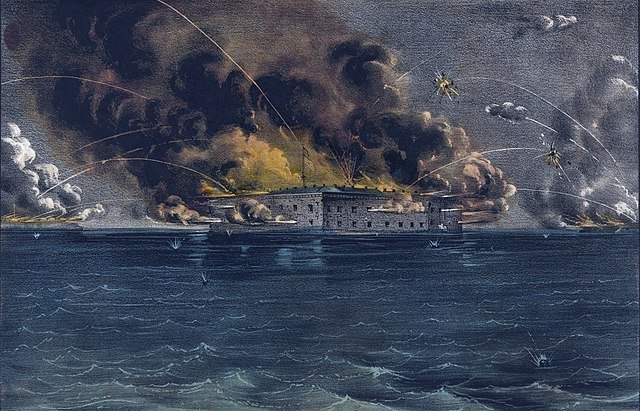
This third-generation Stephen W. Fullerton seemed destined for greatness. He was elected to the New York State Assembly at age 24. His first term was still in session, however, when Southern secessionist forces fired on Fort Sumter and President Lincoln issued an emergency call for volunteers.
Co. B, Third Regiment of Infantry, was the first company recruited and ready for muster in the State. Recruiting for it was commenced in Newburgh immediately after the passage by the Legislature, April 16, 1861, of an act to authorize the equipment of volunteer militia for public safety, the movement being started by Hon. Stephen W. Fullerton, Member of Assembly.
Assemblyman Fullerton did not wait to finish the legislative term but came rushing back to Newburgh to raise volunteers. Young men from surrounding communities on both sides of the Hudson answered the call. When the inexperienced regiment was mustered into service in Albany, Fullerton was elected Captain. The army roll listed him as Stephen W. Fullerton, Jr. This would cause confusion that followed Captain Fullerton and his Uncle Stephen to their graves.
 Company B saw some early, chaotic action in the Battle of Big Bethel, on June 10, after which they were assigned to Fort McHenry, in Maryland, to protect Washington, D.C., against the threat of Confederate invasion. Tragically, the Captain fell deathly ill, likely due to the horrific unsanitary conditions of early Civil War encampments. Sent home to Newburgh with typhoid-like symptoms, he died in a state of delirium, on September 11, 1861.
Company B saw some early, chaotic action in the Battle of Big Bethel, on June 10, after which they were assigned to Fort McHenry, in Maryland, to protect Washington, D.C., against the threat of Confederate invasion. Tragically, the Captain fell deathly ill, likely due to the horrific unsanitary conditions of early Civil War encampments. Sent home to Newburgh with typhoid-like symptoms, he died in a state of delirium, on September 11, 1861.
A sad memorial service was held at St. George’s Episcopal Church in Newburgh. His grieving lawyer uncles William and Stephen paid for a memorial volume to be privately printed in honor of their beloved nephew. Captain Fullerton’s memory was cherished for many years to come, and Newburgh’s Grand Army of the Republic Post No, 58 was named in honor of Captain Stephen Fullerton, Jr.
A Street Named “Fullerton”.
A privately published 1935 booklet covering Newburgh’s street names states that in 1871, “I Street” had been renamed Fullerton Avenue, in honor of two prominent lawyers, William Fullerton, and Stephen W. Fullerton. 
Careful research by former Town of Newburgh Historian Joseph Santacroce found that the street renaming actually took place three years earlier, in 1868. Moreover, it is difficult to see why Newburgh, three years after the travails of the Civil War, would name an important thoroughfare after two mid-career trial lawyers. But it would make perfect sense for those same two lawyers to have lobbied for the street to be named after a local hero, their tragically deceased nephew, Captain Fullerton.
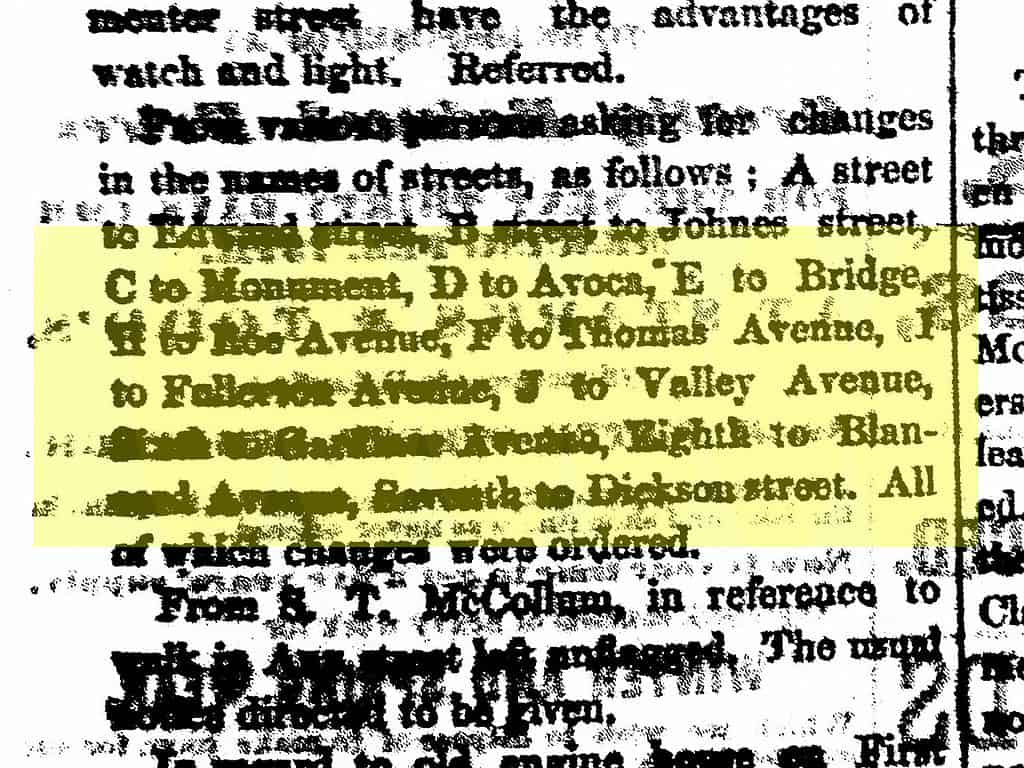
A Grave Mistake.
As noted earlier mentioned at the beginning, all three Stephen W. Fullarton’s are buried in Hillside Cemetery. It is possible that some of them were moved from other locations, by later family members. Unfortunately, the cemetery’s original records were destroyed in an early 20th-century fire. In a strange twist of fate, Whit’s grave (which lists his name as Stephen W. Fullerton, Jr.) describes him erroneously as a Civil War Captain (Company K, Regiment D).
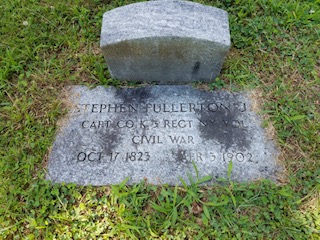
The real Captain Fullerton shares a simple stone with his father Daniel, in a separate part of the same cemetery. There is no mention of the Civil War service that cost his life.
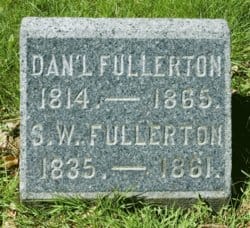
A Tribute from the Last of the OC Judge Fullertons
In 1892, another young lawyer-politician (and future judge) – Henry Benjamin Fullerton – gave a touching address at a Memorial Day celebration in Port Jervis. Henry Fullerton was the grandson of Daniel Fullerton. Had he survived, Captain Fullerton would have been Henry’s uncle. In his speech, this next-gen Fullerton told the holiday crowd about a woman still living in a neighboring town, who had been engaged to Captain Fullerton at the time of his death. Beautiful and accomplished, she had never married after his death, turning down many suitors. This nameless, widow-like figure, is an apt symbol of the personal cost of that terrible war, which had torn apart the still-young nation.
But unbeknownst to most of us, the Captain’s memory is still alive and honored today, on Newburgh street signs that read “Fullerton Ave”!
Michael Aaron Greene